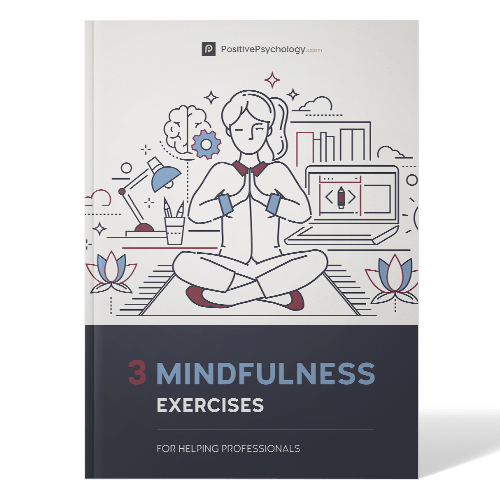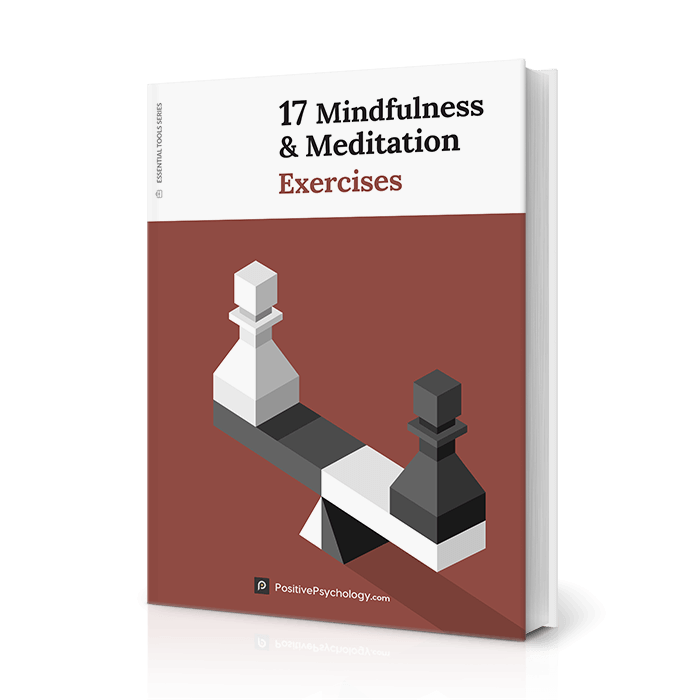Practicing Mindfulness in Groups: 8 Activities and Exercises
 When someone is described as being mindful, it typically means they pay attention to what is happening to the mind, body, and surroundings, and they remain present while both curious and compassionate.
When someone is described as being mindful, it typically means they pay attention to what is happening to the mind, body, and surroundings, and they remain present while both curious and compassionate.
But what does mindfulness do?
One of the best definitions comes from Dr. Shauna Shapiro (2020):
“Mindfulness helps us see clearly so we can make wise choices and respond to life effectively.”
This simple statement captures the ability of mindfulness to help us take a breath and make more considered decisions that improve our lives.
And isn’t that what we all want?
Imagine your life based on choices made from the heart that line up with your core values. That’s what you get – most of the time – when you are mindful.
And yet, practicing mindfulness can feel solitary or perhaps even lonely. So, what do you do?
The answer comes from one of our most basic human needs: seek companionship. Group mindfulness offers fellowship, support, and learnings that may be absent when practicing alone.
This article discusses the benefits of performing mindfulness with others and describes activities that work well in a group setting.
Before you continue, you might like to download our three Mindfulness Exercises for free. These science-based comprehensive exercises will help you cultivate a sense of inner peace throughout your daily life and also give you tools to enhance the mindfulness of your groups.
This Article Contains:
What Is Group Mindfulness?
Humans are social animals. We have evolved to connect and share our thoughts and beliefs with other like-minded individuals.
And we don’t need to be on our own to be mindful.
While mindfulness can be learned through books, apps, audio, and videos, there are times when practicing within a group setting provides better results.
Indeed, over the last two decades, the popularity of mindfulness has soared, as have the opportunities to connect with others on a similar journey. Groups are now available in meetups, workplaces, healthcare providers, and gyms.
Group motivation
We all need motivation, even when we know something is good for us. Whether it’s going for a run, eating well, or practicing mindfulness, we sometimes need support.
To increase the likelihood that we persist, we must be intrinsically motivated – driven by internal rewards – and meet our basic psychological needs (Ryan & Deci, 2018).
For group mindfulness to sustain and maintain our commitment, we need to feel connected. We must experience a sense of belonging and own our decisions and actions while experiencing opportunities, support, skill development, and growth as an individual.
Indeed, organized group meditation provides an opportunity for those who might not practice alone to show up.
Taking our three key psychological needs (Ryan & Deci, 2018) in turn, we look at how organized group meditation meets them and enhances our motivation.
Relatedness
Like any activity, when performed as part of a group, we can motivate one another.
Having others present during a mindfulness session can boost our resolve and provide a sense of ‘we are in this together,’ especially when we are prone to distraction. Booking time and committing to others can mean we are more likely to turn up.
Social facilitation theory suggests that people act better or deliver more when they are being watched or competing with others.
Surprisingly, individuals even eat more when part of a group than when alone (Herman, 2017).
Competence
We all doubt our abilities; it’s part of being human, yet we crave feelings of competence (Ryan & Deci, 2018).
Having the support of a group and the opportunity to talk about the difficulties we face can help calm fears and doubts.
If the leader makes time for the group to discuss the challenges they face, each session can provide a valuable opportunity to share solutions.
Autonomy
“Creating a therapeutic environment that supports autonomy needs is an especially important task for the therapist” (Dwyer, Hornsey, Smith, Oei, & Dingle, 2011).
Autonomy is especially true in mindfulness, where the needs of each individual must be captured and met by the group session.
A no judgment rule must be set to ensure each person feels they are in a safe space to air concerns, hopes, or challenges they are facing.
While it may sound counterintuitive, mindfulness as a group may have fewer distractions and offer a more profound experience. However, we must also take into account the varying levels of experience and the abilities of each individual.
Let’s take a look at three research areas that have found success using the group approach.
Examples of group mindfulness
 Mindfulness-based cognitive therapy
Mindfulness-based cognitive therapy
Mindfulness-based cognitive therapy (MBCT) has been used successfully in a wide variety of settings and for several different mental health issues.
Practitioners work with the group to identify and respond to thoughts, feelings, and bodily sensations to decrease the severity of symptoms and improve overall life functioning (Lenz, Hall, & Bailey Smith, 2015)
The group environment supports individuals through social comparison. We each have an innate drive to compare ourselves with one another, and it can be used to normalize our experiences of depression and provide ongoing support.
Sharing personal experiences and giving feedback within the group supports the development process, ensures accountability for the completion of weekly homework, and illuminates collective meaningfulness (Segal, Williams, & Teasdale, 2002).
A typical group session might consist of the following:
- Begin with a mindfulness practice, such as a body-scan.
- Explore the theme of the session(s).
- Use participatory dialogue to investigate and explore experiences.
- Introduce short mindful sessions to break down some of the formality of the therapy.
- Wrap up with a short mindfulness session.
Mindfulness and asthma
There are 330 million people around the world who are impacted by asthma. In the UK alone, someone has a severe asthma attack every 10 seconds, with three people dying every day.
And for some, existing treatments do not work.
Many patients with asthma suffer frequent bouts of psychological stress and anxiety. As a result, researchers are turning their attention to understand the links between anxiety and asthma, and approaches that may help.
A 2020 study exploring the impact of group mindfulness therapy using both MBSR and MBCT in people with asthma found significant improvements in both anxiety and stress (Ainsworth et al., 2020).
Adolescent anxiety
Anxiety is common within school-age groups. Although Cognitive-Behavioral Therapy (CBT) interventions have had some success, they are not commonplace, and up to 50% of cases are still coping with symptoms when they finish.
Group sessions for mindfulness have proved successful at lowering stress and anxiety and improving attention in school settings where time and resources prohibit individual sessions (Crowley et al., 2017).
5 Activities for Your Group Therapy
Mindfulness-based activities can work well in both solo and group environments; however, though the steps remain similar when including group dynamics, peer pressure, and social facilitation, we can get different and possibly better results.
And yet, it is essential that when used in a group setting, mindfulness techniques successfully cater to different histories, personalities, and personal challenges within the group.
It is also vital to reach agreement on openness and lack of judgment when listening to each other’s views. If the session is perceived as unsafe, its benefits will be compromised.
The following techniques are particularly useful in a group environment.
1. Goal setting
The goals of each individual within the session must be understood and aligned with those of the group.
If members permit, goals can be shared within the group to provide useful insights and points of discussion. Otherwise, record the goals privately, and remove personal details before sharing within the session.
If the timeframe is insufficient to tackle goals, then break them down and address them separately.
2. Anchor breathing
In groups, meditation principles may need to begin slowly to allow individuals time to become comfortable with the idea of performing meditations within a shared space. They may have previously only practiced on their own, or they could be new to the practice altogether.
A good starting point is to focus awareness on breath and body.
Instruct the group to observe their thoughts, emotions, and physical sensations while remaining curious and compassionate.
This Anchor Breathing exercise provides an ideal introduction to mindfulness and works as a first group activity.
3. Breathing together
Building on the last exercise, we are mostly unaware of the breaths we take.
Paying attention to our breathing can improve our ability to focus, feel, sense, and be present.
Work in pairs to perform the Yogic Breathing exercise.
While this exercise works well to strengthen our mindfulness, it also encourages us to build personal relationships and drop barriers when performed in a group setting.
For some, this process may feel too personal. And yet, by performing within a larger group, the individual may receive confidence from seeing others perform this intimate therapy.
Yogic Breathing can also be well suited to couple’s therapy.
4. Silent Connections
The Silent Connections exercise is perfect for group settings.
In this activity, the group has a chance to engage with other members and leverage the mindfulness of others to build stronger, positive connections without speaking.
Participants are asked to follow two steps:
- Walk around the room silently while trying to communicate with one another silently – no speaking allowed!
- Using only non-verbal cues such as eye contact, smiling, and facial expressions, participants must try to immerse themselves in the experience of building silent connections with one another.
5. Mindful movement
All that is important is this one moment in movement. Make the moment important, vital, and worth living. Do not let it slip away unnoticed and unused.
Martha Graham
The Mindful Movement meditation that accompanies the book Mindfulness: The Eight-Week Meditation Programme for a Frantic World (Williams & Penman, 2011) helps focus the mind through movement.
It is especially useful where members of the group struggle to focus during static exercises such as the body-scan meditation.
The audio guides you through a set of movements, gently performed while maintaining focus on each breath and becoming fully alive to the sensations that accompany them.
3 Useful Exercises for Adults

The following three exercises lend themselves more readily to being performed in an adult, group environment and explore mindsets that can help us overcome life’s difficulties.
1. Acceptance
When things don’t go our way, we often become upset and annoyed.
However, sometimes this resistance is pointless.
It’s raining, and I have 30 people arriving. The barbecue is ruined.
Acceptance, on the other hand, brings calmly considered options.
If it rains on the day planned for the family barbecue, then so be it. I cannot change the weather.
It can be rescheduled or moved under cover.
Still, we must remain vigilant. Acceptance must not lead to a mindset of ‘giving up’ too quickly, but rather to one that identifies new opportunities.
The following steps take us through a meditation of acceptance (modified from Shapiro, 2020):
- Sit comfortably and relax.
- Become aware of your breathing.
- Inhale deeply and slowly.
- Observe each breath.
- Attend to the present moment with kindness and curiosity.
- Bring to mind an area of your life that has caused you pain.
- Ask yourself, what resistances are there? What effect are they having on me and others?
- How would it feel if I were more accepting? After all, I cannot change what has happened.
- Notice how this feels.
If comfortable, the individual’s thoughts can be shared and discussed with the group.
Finally, ask yourself, does shifting how you relate to the pain change the amount of suffering?
2. Vulnerability
This TED Talk by researcher and storyteller Brené Brown is a humorous and brave exploration of her vulnerabilities.
Watch and discuss as part of a group.
Share similar stories and discuss times when you have felt exposed or vulnerable.
Understand that despite our differences, everyone shares the same fears and concerns.
3. Forgiveness
Forgiveness is never easy. When it is most needed, it is often the most difficult to give.
Yet, learning to forgive can be intensely transformational.
To perform well, you need to accept what has happened and show compassion. And it can help to see something from another person’s point of view.
For example, if we understand and empathize with the person who lied to us, we can learn to forgive with compassion.
But, most importantly, forgiveness reduces our suffering. As Dr. Shapiro (2020) writes, “it opens our future by liberating it from burdens of the past.”
And it is not always others we need to forgive (Williams & Penman, 2016). We must also forgive ourselves for what we have done wrong or failed to do in the past.
The act of forgiveness is also good for our wellbeing, reducing anger, depression, and stress (Freedman & Zarifkar, 2016).
The following meditation helps us visualize not only the act of forgiveness but also acceptance.
- Sit comfortably and relax.
- Become aware of your breathing.
- Inhale deeply and slowly.
- Observe each breath.
- Attend to the present moment with kindness and curiosity.
- Focus on your breath and body, and relax.
- Visualize who has harmed you.
- Become aware of the feelings and physical sensations they invoke.
- Say to them, “I forgive you.”
The above meditation should focus on one act of forgiveness at a time.
An additional 22 Mindfulness Exercises are available if you enjoyed the above ideas.
Mindfulness Activities for DBT Group Sessions
Dialectical Behavior Therapy (DBT) is a talking therapy based on CBT.
The word ‘dialectical’ refers to the need to hold opposing views in our minds, to accept who we are and yet to change our behavior.
DBT combines cognitive therapy and mindfulness to overcome rigid ways of thinking and helps us understand and ultimately accept painful feelings.
We can then learn the skills required to manage these feelings and make positive changes to our life.
Project Air Strategy provides a valuable source of information for helping people with personality disorders. Their DBT manual provides some essential tools and guidance for therapy within groups.
Check out some of the mindful exercises in Appendix 1 of the DBT manual, including ‘Safe Place Mindfulness,’ ‘Progressive Muscle Relaxation,’ and ‘Urge Surfing with Chocolate.’
Resources From Our Toolkit
We have many resources at PositivePsychology.com that will help you to start and maintain mindfulness practices. Most work well in or can be tailored for group settings, such as the 3-Step Mindfulness exercise. In this exercise, participants must practice stepping out of autopilot, becoming aware of their breath, and expanding their awareness outward.
The Mindfulness X© course is based on the hugely successful training provided by our own Dr. Hugo Alberts. The eight-session mindfulness training will guide you through the powerful effects of mindfulness for use by yourself or within a group.
If you’re looking for more science-based ways to help others enjoy the benefits of mindfulness, this collection contains 17 validated mindfulness tools for practitioners. Use them to help others reduce stress and create positive shifts in their mental, physical, and emotional health.
A Take-Home Message
Mindfulness is awareness that arises through paying attention, on purpose, in the present moment, non-judgementally.
Kabat-Zinn
Learning mindfulness is a journey, one in which the final destination may be unclear with plenty of opportunities to take a wrong turn and become lost along the way.
Sometimes we need help.
In this media-driven world where we spend too much time on inauthentic conversations, there are times when genuine support and community are both helpful and insightful.
If you or your students are finding mindfulness techniques challenging, then it is perhaps time to work together, within a group.
Go online or talk to a fellow practitioner and find out what classes are available. Or set up something yourself. After all, a basic psychological need and a central tenet of mindfulness is to form relationships with oneself, others, and our environment.
Mindfulness is as much about connecting with each other and the world in which we live as it is about being comfortable in our mind and body.
Perhaps it’s time to reach out.
We hope you enjoyed reading this article. Don’t forget to download our three Mindfulness Exercises for free.
- Ainsworth, B., Patel, A., Eyles, C., Davies, G. E., Kurukulaaratchy, R., & Thomas, M. (2020). Feasibility and acceptability of a group mindfulness intervention in a difficult asthma clinic. Mindfulness, 11, 1734–1746.
- Crowley, M. J., Nicholls, S. S., McCarthy, D., Greatorex, K., Wu, J., & Mayes, L. C. (2017). Innovations in practice: Group mindfulness for adolescent anxiety – Results of an open trial. Child and Adolescent Mental Health, 23(2), 130–133.
- Dwyer, L. A., Hornsey, M. J., Smith, L. G. E., Oei, T. P. S., & Dingle, G. A. (2011). Participant autonomy in cognitive behavioral group therapy: An integration of self-determination and cognitive behavioral theories. Journal of Social and Clinical Psychology, 30(1), 24–46.
- Freedman, S., & Zarifkar, T. (2016). The psychology of interpersonal forgiveness and guidelines for forgiveness therapy: What therapists need to know to help their clients forgive. Spirituality in Clinical Practice, 3(1), 45–58.
- Herman, C.P. (2017) The social facilitation of eating or the facilitation of social eating? Journal of Eating Disorders, 5, 16.
- Lenz, A. S., Hall, J., & Bailey Smith, L. (2015). Meta-analysis of group mindfulness-based cognitive therapy for decreasing symptoms of acute depression. The Journal for Specialists in Group Work, 41(1), 44–70.
- Ryan, R. M., & Deci, E. L. (2018). Self-determination theory: Basic psychological needs in motivation, development, and wellness. The Guilford Press.
- Sanbonmatsu, D. M., Strayer, D. L., Medeiros-Ward, N., & Watson, J. M. (2013). Who multi-tasks and why? Multi-tasking ability, perceived multi-tasking ability, impulsivity, and sensation seeking. PLoS ONE, 8(1), e54402.
- Segal, Z. V., Williams, J. M. G., & Teasdale, J. D. (2002). Mindfulness-based cognitive therapy for depression—A new approach to preventing relapse. Guilford Press.
- Shapiro, S. L. (2020). Rewire your mind: Discover the science + practice of mindfulness. Aster.
- Williams, M., & Penman, D. (2011). Mindfulness: The eight-week meditation programme for a frantic world. Hachette Audio.
- Williams, M., & Penman, D. (2016). Mindfulness: A practical guide to finding peace in a frantic world. Piatkus Books.
Let us know your thoughts
Read other articles by their category
- Body & Brain (50)
- Coaching & Application (57)
- Compassion (26)
- Counseling (51)
- Emotional Intelligence (24)
- Gratitude (18)
- Grief & Bereavement (21)
- Happiness & SWB (40)
- Meaning & Values (26)
- Meditation (20)
- Mindfulness (45)
- Motivation & Goals (45)
- Optimism & Mindset (34)
- Positive CBT (29)
- Positive Communication (20)
- Positive Education (47)
- Positive Emotions (33)
- Positive Leadership (18)
- Positive Parenting (4)
- Positive Psychology (33)
- Positive Workplace (37)
- Productivity (17)
- Relationships (46)
- Resilience & Coping (38)
- Self Awareness (21)
- Self Esteem (38)
- Strengths & Virtues (32)
- Stress & Burnout Prevention (34)
- Theory & Books (46)
- Therapy Exercises (37)
- Types of Therapy (64)
 Mindfulness-based cognitive therapy
Mindfulness-based cognitive therapy





What our readers think
Sharing a thought of what came to me and was my take
away after reading the
Take-Home Message
Pre /Prior to
“the willingness intent desire and act of paying attention”
Pre /Prior to
” awareness arising ”
irrespective of reason and mode of its arising that is irrespective of its arising through (willingness -intent -desire – habit- routine – act etc leasing and causing – the act of paying attention,
I am…
I just am…
I am…
I just am…
I am…
I just am…
unchanged…
unchanging…
whole pure ..
still …….
Thank you for the well researched piece. Please let me have some of the mindfulness exercises you recommend for groups.
Hi Ferdinand,
Glad you enjoyed the post! If you click on the blue hyperlinked text in the article regarding the relevant exercise, you should be able to download it.
Hope this helps!
– Nicole | Community Manager
Please send me copies of the three free mindfulness exercises you are offering.
Thank you.
Hi Chris,
Please visit the following link to have the three free mindfulness exercises delivered to your inbox: https://pro.positivepsychology.com/opt-in/3-free-mindfulness-tools/.
Thank you 🙂
– Nicole | Community Manager